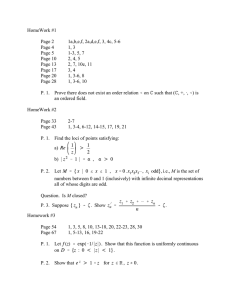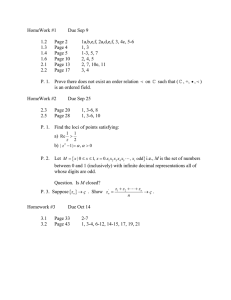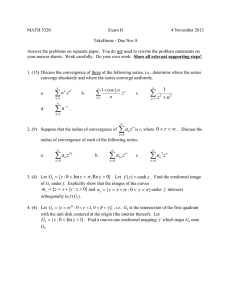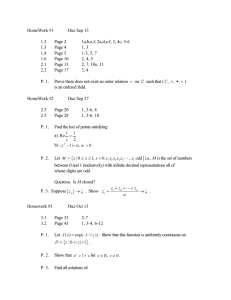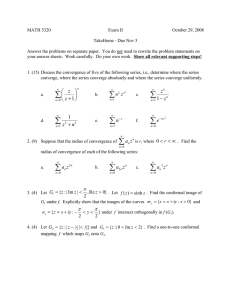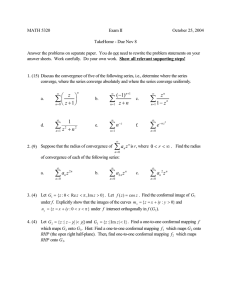THE (3.1) ON ME-MANIFOLD IN n-*g-UFT AND ITS
advertisement
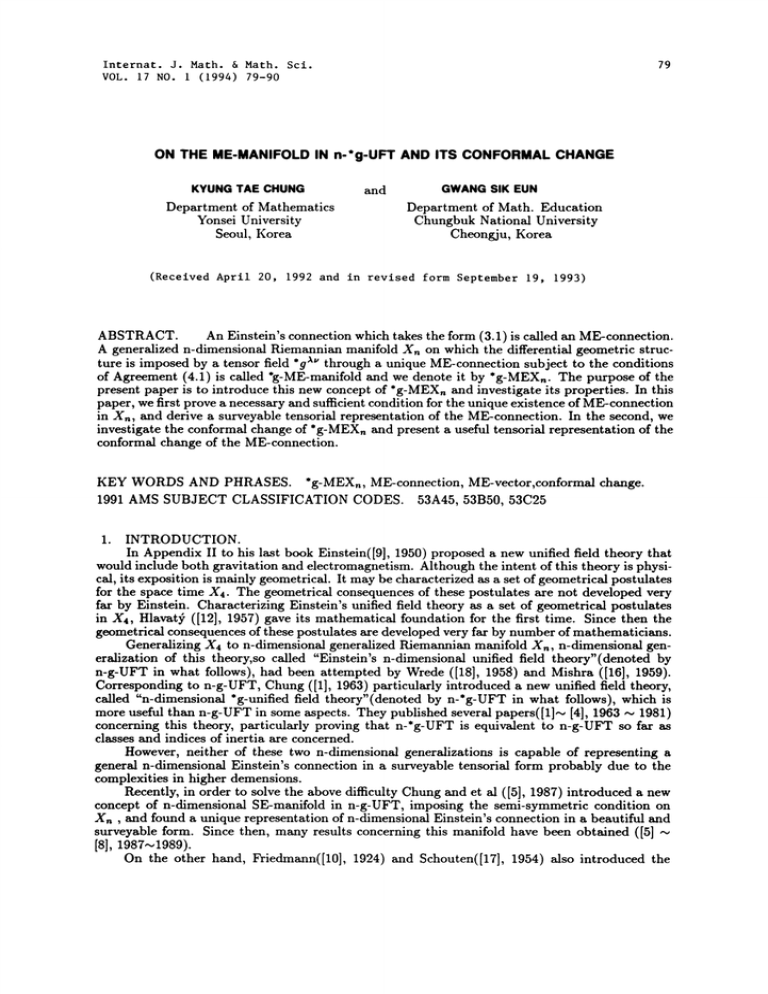
Internat. J. Math. & Math. Sci.
VOL. 17 NO.
(1994) 79-90
79
ON THE ME-MANIFOLD IN n-*g-UFT AND ITS CONFORMAL CHANGE
KYUNG TAE CHUNG
and
GWANG SlK EUN
Department of Mathematics
Department of Math. Education
Yonsei University
Chungbuk National University
Cheongju, Korea
Seoul, Korea
(Received April 20, 1992 and in revised form September 19, 1993)
ABSTRACT.
An Einstein’s connection which takes the form (3.1) is called an ME-connection.
A generalized n-dimensional Riemannian manifold X, on which the differential geometric structure is imposed by a tensor field *gx through a unique ME-connection subject to the conditions
of Agreement (4.1) is called "g-ME-manifold and we denote it by "g-MEX.. The purpose of the
present paper is to introduce this new concept of *g-MEX. and investigate its properties. In this
paper, we first prove a necessary and sufficient condition for the unique existence of ME-connection
in X,, and derive a surveyable tensorial representation of the ME-connection. In the second, we
investigate the conformal change of "g-MEX,, and present a useful tensorial representation of the
conformal change of the ME-connection.
KEY WORDS AND PHRASES. "g-MEX,,, ME-connection, ME-vector,conformal change.
1991 AMS SUBJECT CLASSIFICATION CODES. 53A45, 53B50, 53C25
1.
INTRODUCTION.
In Appendix II to his last book Einstein([9], 1950) proposed a new unified field theory that
would include both gravitation and electromagnetism. Although the intent of this theory is physical, its exposition is mainly geometrical. It may be characterized as a set of geometrical postulates
for the space time X4. The geometrical consequences of these postulates are not developed very
far by Einstein. Characterizing Einstein’s unified field theory as a set of geometrical postulates
in X4, Hlavat: ([12], 1957) gave its mathematical foundation for the first time. Since then the
geometrical consequences of these postulates are developed very far by number of mathematicians.
Generalizing X4 to n-dimensional generalized Riemannian manifold X,, n-dimensional generalization of this theory, so called "Einstein’s n-dimensional unified field theory" (denoted by
n-g-VET in what follows), had been attempted by Wrede ([18], 1958) and Mishra ([16], 1959).
Corresponding to n-g-UFT, Chung ([1], 1963) particularly introduced a new unified field theory,
called "n-dimensional *g-unified field theory" (denoted by n-*g-UFT in what follows), which is
more useful than n-g-UFT in some aspects. They published several papers([1].- [4], 1963
1981)
concerning this theory, particularly proving that n-*g-UFT is equivalent to n-g-VET so far as
classes and indices of inertia are concerned.
However, neither of these two n-dimensional generalizations is capable of representing a
general n-dimensional Einstein’s connection in a surveyable tensorial form probably due to the
complexities in higher demensions.
Recently, in order to solve the above difficulty Chung and et al ([5], 1987) introduced a new
concept of n-dimensional SE-manifold in n-g-VET, imposing the semi-symmetric condition on
X. and found a unique representation of n-dimensional Einstein’s connection in a beautiful and
surveyable form. Since then, many results concerning this manifold have been obtained ([5]
[8], 19871989).
On the other hand, Friedmann([10], 1924) and Schouten([17], 1954) also introduced the
K.T. CHUNG AND G.S. EUN
80
idea of semi-symmetric connection, and Hayden ([11], 1932) the concept of metric connection.
Recently, Yano ([20], 1970),Yano & hnai ([19], 1975) and Imai ([13], 172; [4], 73) assigned
a semi-symmetric metric connection to an n-dimensional Riemannian manifold and found many
results concerning this manifold.
Recently, Ko ([15], 1987) and Yoo ([2]. lSS)introduced a new concept of ME-manifold in
n-g-UFT, assigning to X,, a ME- connection which is similar to Yano and Imai’s semi-symmetric
metric connection, and investigated its curvature tensors and conformal change in n-g-UFT. The
purpose to introduce this manifold is similar to Chung’s purpose to introduce SE-manifold.
The purpose of the present paper is to introduce a new concept of the n-dimensional *g-MEmanifold (denoted by *g-MEX,, ), assigning an Einstein’s connection of the form (3.1) to Xn,
called a ME-connection in what follows, and investigate its properties. This paper consists of
five sections. The second section introduces some preliminary notations, definitions, and results.
The third section concerns with a necessary and sufficient condition for the existence of unique
ME-connection in n-*g-UFT.
The fourth section deals with a precise tensorial representation of the ME-connection in terms
of
In the last section, we investigate the conformal change of *g-MEX,, with particular
emphasis on the conformal invariants of *g-MEXn. In this section, we display a surveyable
tensorial representation of the conformal change of the ME-connection
2. PRELIMINARIES.
This section is a brief collection of the basic concepts, notations, and results, which are needed
in our further considerations in the present paper. It is based on the results and symbolisms of
.gx.
Hlavat]( [43] ,1957) and Chung([10], 1963; [13], 1981; [161, 1985).
A. n-DIMENSIONAL *g-UNIFIED FIELD THEORY.
Hlavat characterized Einstein’s 4-dimensional unified field theory (4-g-UFT) as a set of
geometrical postulates in a space-time X4 for the first time and gave its mathematical foundation.
Generalizing this theory we may consider Einstein’s n-dimensional unified field theory(n-g-UFT).
Similarly, our n-dimensional *g-unified field theory(n-*g-UFT), initiated by Chung(1963) and
originally suggested by Hlavat:(1957), is based on the following three principles.
Principle A. Let X,, be a n-dimensional generalized Riemannian manifold referred to a real
coordinate system x", which obeys coordinate transformation x"
x for which
-
Det(
’’
(2.1)
#0
Let q, be a general real nonsymmetric tensor which may be decomposed into its symmetric part
hxt, and skew-symmetric part
g.t,
h., + k.,
(2.2)
where
g
The algebraic structure on
Det(gx,) # O,
I}
Det(hx,) # 0
(2.3)
Xn is imposed by the basic real tensor *gX, uniquely defined by
g,, g
,
(2.4)
It may also be decomposed into its symmetric part *h xu and skew-symmetric part *k x
gX= .hX +
,kx
(2.5)
(*) Throughout the present paper,Greek indices are used for the holonomic components of tensors in X,.
They take the values 1,2,... ,n, n>l, and follow the summation convention.
81
ME-MANIFOLD AND ITS CONFORMAL CHANGE
Since Det(" h x’)# 0, we may define a unique
tensor*hat, by
*ha *h A‘"
‘"
(2.6}
In n-*g-UFT we use both *h A‘" and *h.xu as the tensors for raising and/or lowering indices of all
tensors defined in X, in the usual manner. We then have
(2.7)a
so that
*hx, + *kx,
*gx,
(2.7)b
Principle B. The differential geometrical structure on X, is imposed by the tensor *ga‘"
by means of a connection Fa‘’, defined by a system of equations, so called Einstein’s equations
D," gX,
_2S,.,,,,,,ga,,, (,)
(2.8)
Here D denotes the symbol of the covariant derivative with respect to F aV, and SA,‘" is the
torsion tensor of Fa‘’,. The connection Fav, satisfying (2.8) is called an Einstein’s connection.
Principle C. In order to obtain *ga‘" involved in the solution for Fx‘’u centain conditions
are imposed. These conditions may be condensed to
SA def SAv
where
0[,Ya],
RI,X]
0,
Rt,x)
0
(2.9)
Yx is an arbitrary vector and
R,a‘" def,.,
zLa[,Zla
,l
+ F‘’[,FlaI’,I)
are curvature tensors of X,.
In the following Remark, we state the main differences between n-g-UFT and n-*g-UFT.
n-g-UFT
the algebraic structure is imposed on X, by the tensor
REMARK 2.1. In
n-*g-UFT
{gx,gX
and
{
the tensor h x and
the tensor
hX
and h
tensors in X, On the other hand, in
are used for raising
n-g-UFT
the differential geometrical structure is imposed
n-*g-UFT
(*) It has been shown by Hiavat:#(1957) that the system (2.8)
Dgx,
which is the original Einstein’s equation.
and/or lowering the indices of
2Sagxa
is equivalent to
(2.8)’
82
on
K.T. CHUNG AND G.S. EUN
X.
by
gxu
.gx,,
through
Fx", satisfying
it will be expressed in terms of
{ (2.8)(’)’8)’
admits a solution
l"x",,
gx,, in n-g-UFT
.gX in n-*g-UFT
B. SOME NOTATIONS AND RESULTS.
The following quantities are frequently used in our further consideration:
*O Det(*gxt,), *11 Det(*hx,),
/ 0,
*1
(2.12)a
Det(*kx,,)
if n is even
(2.12)c
1, ifnisodd
()*kx’
6x
(])*k.
*kx ’, (P)*kx
(P)*kx (P-l)*koU
kIo
k,,l
ko,
,p
p
(2.12)d
1,2,
(2.12)c
2,...
An eingenvector V of kxs, which satisfies
(M* h x,, + kx.) V
M is a scalar
0,
is called a basic vector of X,, and the corresponding eigenvalue M of kx, a basic scalar of X,.
The following theorems have been proved already in a X, ([101, 1963; [13], 08).
THEOREM 2.1. The following relations hold in a X,"
/t0=l,K.=*k, ifniseven
h’
if p is odd
0,
(2.14)a
(2.14)b
-
K. ("-’)*kx"
0
(2.14)c
8=0
Here and in what follows, the index s is assumed to take the values 0,2,4,- in the specified range.
THEOREM 2.2. The basic scalars M satisfy the following equation:
K, M"-"
O
(2.15)
THEOREM 2.3. If the system (2.8) admits a solution I’x,, it must be of the form
,,
*{ ,,} + Sx,," +
(2.16)
where { x", are the Christoffel symbols defined by *hx, and
(2.17)
ME-MANIFOLD AND ITS CONFORMAL CHANGE
83
THE ME-CONNECTION IN n-*g-UFT
In the section, we introduce the concept of ME-connection in n-*g-UFT and devote mainly
3.
to the proof of a necessary and suffcient condition for the existence of ME-connection in a general
Xn.
DEFINITION 3.1. An Einstein’s connection
I’x’v of the form
(3.1)
for a non-null vector
ME-vector.
Xx
is called a ME-connection in n-*g-UFT, and
If Xn admits a ME-connection
(2.16) and (3.1)
Xx
the corresponding
Fxu, it must also be of the form (2.16). Hence, comparing
we have
Sx
2//[x"X] 2*kxX
*U, 2//(xX) 2*hX"
THEOREM 3.2. If X, admits a ME-connection F", the ME-vector Xx
relation
26(’X) 2*hxX + 2(2)*kxX *hx,*k,vX 0
or
(3.2)
(3.3)
satisfies the
(3.4)a
equivalently
2*ht,X,, + 2 (2)*kt,X + *hxt,*k,,’X,,,
2*h,(xXs,
0
(3.4)b
Proof. The relation (3.2) gives
S".xt,
6’Xx + 2*kx’X *hxX
(3.5)
Substituting (3.2) and (3.5) into the righthand side of (2.17),we have
(3.6)
Our relation (3.4)a immediately follows by comparing (3.3) and (3.6). The equivalence of
(3.4)a and (3.4)b is obvious.
THEOREM 3.3.
A necessary and sufficient condition for the system (2.8) to admit a
solution rx", of the form (3.1) is
(3.7)a
or equivalently
V,.,*kxg
2(*hw[xXl -*kxX,,., + *h,,.,Ix*klaXa)
(3.7)b
Proof. Suppose that the system (2.8) admits a solution Fx’t, of the form (3.1). Substituting
(3.1) into the left-hand side of (2.8), we have
(3.8)a
On the other hand, substitution of (3.2) into the right-hand side of (2.8) g4ves
_2S. .gX
_26w.X x + 2. gXX + 4.k,,,XX
26,.kxaX
4 (2)*k,,,XX s‘
(3.S)b
84
K.T. CHUNG AND G.S. EUN
The condition (3.7)a results from (3.8)a and (3.8)b. Conversely, assume now that the condition
(3.7)a is satisfied. Define a connection F‘’, by (3.1), and substitute it into both sides of (2.8).
This substitution yields the relation (3.7)a, which is satisfied by our assumption. Hence, a connection of the form (3.1) is an Einstein’s connection under the condition (3.7)a. In order to show
the equivalence of (3.7)a and (3.7)b, consider the following alternative form (3.7)a:
-2"gt,X,., + 2" h,.o,Xt,
V,,," k,,
2* h,.,t," kX, -4 {2)" k,,( ,Xt,
(3.9)
The equivalence immediately follows from (3.9) in virtue of (3.4)b.
REMARK 3.4. Using (3.4)b and (3.9), it can be easily shown that the following relation is
also equivalent to (3.7)a:
V,,,*k. t,
*kxgX,.,
2(4*k,4xXt,
2
(2)*k,,,[xX,])
(3.10)
In our further considerations we shall assume that the tensor
A,, ’ -n*g + *g
(3.11)
is of rank n, so that there exists a unique tensor B x‘" satisfying the condition
Axt, B x"
THEOREM 3.5.
one ME-connection
At, xB "x
(3.12)
A necessary and sufficient condition for the system (2.8) to admit exactly
F,
of the form (3.1) is that the tensor field
*g’‘"
satisfies the following
condition:
V,*k t,
2(*h,[*g,]- *h,*kx,)Co, B
(3.13)
If this condition is satisfied, then
X‘" =CAB""
(3.14)
where
(3.15)
Cx V,*kx
If the system (2.8) admits a solution Fx‘’, of the form (3.1), the condition (3.7)b
Proof.
must hold in virtue of Theorem
have
(3.3). Raising the index p and putting w
C,
A,,X"
ft
a in
(3.7)b
we
(3.16)
in virtue of (3.11) and (3.15). Multiplication of B x‘" to both sides of.(3.16) gives (3.14) in virtue
of (3.12). The condition (3.13) now follows by substituting (3.14) into (3.7)b. The proof of the
converse statement is obvious in virtue of Theorem (3.3).
Besides the ME-connection F, given by (3.1) and (3.14), assume that there exists another
ME-connection
F"t,
{x‘’t,} + 2,‘’X#- 2*gxt, X,,
Xx Xx
(3.17)
Applying the same method to derive (3.14) to this connection, we have
X,
C B
X
,
which is a contradiction to our assumption (3.17). This proves the uniqueness of the
connection under the condition (3.13).
4. *g-ME-MANIFOLD AND A REPRESENTATION OF ITS CONNECTION.
ME-
85
ME-MANIFOLD AND ITS CONFORMAL CHANGE
In this section, we introduce the concei)t of *g-ME-manifold and display a surveyable tensorial representation of a unique ME-connection FxVu in terms of the tensor field "9 xv using two
useful recurrence relations.
AGREEMENT4.1. In our further considerations in the present paper, we impose priori the
following conditions to the tensor field
(a) The quantity
Odd 1-n( 0)
(4.1)
l+n
is not a basic scalar of Xn (see (2.13)).
(b) The condition (3.13) is satisfied by the tensor field ,gX
According to the condition (b), we note that there always exists a unique ME-connection
Fx, in our n-*.g-UFT. In virtue of (3.1) and (3.14), this connection may be given by
(4.2)
DEFINITION 4.2.
An n-dimensional generalized Riemannian manifold X,, on which
the differential geometric structure is imposed by the tensor *gX satisfying the conditions of
Agreement (4.1) by means of the unique ME-connection given by (4.2), is called an n-dimensional
*g-ME-manifold and denoted by *g-MEX,.
In our further considerations in the present paper, we use the following useful abbreviations
for an arbitrary vector Vx, where p=2,3,4,...
e=
(1)Vx d V
In virtue of (2.12)d,
P
Vx de__[ (p_l),kxO V,
(4.3)a
we then have
(P)V *kx (P-)V
(1)Vy
For s=2,4,... ,n-a,
V
(p)V
(p-1),ku V
(4.3)b
*k
(p-1)VC
(4.3)c
we also use the following quantities:
H0
k0
Ho
1,
0 H,-2
+ K0
(4.4)
In virtue of (2.12)c and (2.14)a, direct calculations show that
K, 8 -’
H,
(4.5)
$--0
In particular,
H,_
E Ko 8
(4.6)
--0
THEOREM 4.3. In *g-MEX, the following recurrence relation holds"
(P)XA O(P-1)X,
where 0 and
Cx
are
1
l+n
(P-’)Cx(p
respectively given by (4.1) and (3.15).
2, 3, 4,...
(4.7)
86
K.T. CHUNG AND G.S. EUN
Proof.
Substituting (3.11) into (3.16),
)Xa
we
have
OX,
1
+n Ca
(4.8)
The relation (4.7) now follows by multiplying (’-2)*ku to both sides of (4.8) and making use of
the abbreviations (4.3).
THEOREM 4.4. In *g-MEX,, the following recurrence relation holds:
K, ("-’+)X
(4.9)
0
,--’0
Proof. This relation follows by multiplying X to both sides of (2.14)c and making use of
the abbreviations (4.3).
Application of the recurrence relations (4.7) and (4.9) yields the following surveyable representation of the ME-vector Xx.
THEOREM 4.5. In *g-MEX,, the ME-vector Xa may be given by
X
aH._,,C,
+
H,
(4.10)
,--0
where
d__ (1
+ n)O"H
(P)Q, de2 (P)CA + 0 (P-1)CA,
Proof.
Substitute
(4.11)
p
("+l)Xa from (4.7) into the first
1
l+n
(")C --0(")X), +
(4.12)
2,3,-.. ,n
term of
(4.9) to obtain
Z K’(a-’+I)x’
(4.13)a
,=2
Substituting (")Xx again from (4.7) into the first term on the right-hand side of (4.13)a and
making use of (4.4) and (4.12), we have
1
l+n
(")Q H2 ("-I)Xa +
Z K, ("-’+)X
(4.13)b
,=4
Similarly, the second step may be carried out as in the above first step. The substitution
of ("-I)X. into (4.13)b in the first and that of ("-2)Xx into the resulting relation in the second
give
I
(4.14)
H4 (’-3)X +
+ H2
l+n
s=6
((")Q, ("-2)Q,,)
After
’---
’h’,("-’+)X,,
steps of successive repeated substitution for (P)X from (4.7), we have
1
l+n
((")Qx + H2 (n-2)Q, +... + H,__ (2+a)Q),)
H,
(l+a)Xx
(4.15)
ME-MANIFOLD AND ITS CONFORMAL CHANGE
87
On the other hand, it follows from (2.12)c and (4.8) that
(+)Xa
O"Xx Ca
l+n
(4.16)
Our representation (4.10) immediately follows by substituting (4.16) into (4.15) and making use
of (4.11).
REMARK 4.6. According to the Agreement (4.1)a, 0 is not a basic scalar of X,.
Hence, in *g-MEX. the following relation always holds in virtue of (2.15) and (4.6):
H,,_
(4.17)
0
We note that the relation (4.17) justifies the validity of the representation (4.10). Furthermore,
we also note that the condition (4.17) is a necessary and sufficient condition for X, to admit a
unique ME-vector Xa in n-*g-UFT. This is the reason why we imposed prior the condition of
Agreement (4.1)(a).
Now that we have obtained
a representation of the ME-vector Xa in terms of *gau, it is
possible for us to obtain a surveyable representation of the ME-connection of *g-MEX, in terms
of *ga by simply substituting (4.10) into (3.1). Formally we state
THEOREM 4.7. The ME-connection of *g-MEX. may be given by
(4.18)
where the vectors CA and (’)Qa are respectively defined by (3.15) and (4.12), the quantities H,,_
and by (4.4) and (4.11) respectively, and
(4.19)
5.
on
CONFORMAL CHANGE OF *g-MEX,.
In this section, we investigate change of several geometrical quantities, particular emphasis
the change of the unique ME-vector and ME-connection, induced by a conformal change of
the unified field tensor
Let
*g- MEX.
be n-dimensional *g-ME-manifold,
*g- MEX,
structure is imposed by a unified field tensor field
Fa,
F,,
,0a
given by (4.18)
given by (5.1)
r. =* {.
+
a.
._c +
,
G a, ’,, Ca, and 0a
DEFINITION 5.1. Two manifolds *g-MEX, and *g
(See Agreement (5.2) for
on which differential geometric
through the ME-connection
.
("-’)0
MEX,
(5.1)
are said to be
conformal, if
their basic tensor fields are related by
*y"()
-" *"()(*)
(*) Note that the conformal change defined by (5.2) is equivalent to
definition of conformal change in n-g-UFT
(5.2)
O(x)
eng:x(z),
which is the
88
K.T. CHUNG AND G.S. EUN
where Q fl(.r) is an arbitrary Mnction of position with at least two derivatives.
This conformal change enforces a change of ME-vector and ME-connection, and an explicit
tensorial representation of this change will be displayed in this section.
AGREEMENT 5.2. Throughout this section, we agree that, if T is a fl,nction of *gxt,, then
we denote by T the same function of *Ox,. In particular, if T is a tensor, so is T Furthermore,
the indices of T( will be raised and/or lowered by means of *h xv
and/or *hxt, (*x,)
The following two theorems are immediate consequences of Definition(5.1) and
Agreement( 5.2 ).
THEOREM 5.3. The conformal change (5.2) induces the following changes:
(.xv)
.-,xu
(p),.xv
e
e_ n ,),kXV,
_fl
,hX
,-
hx#
en
(P)*’A,
THEOREM 5.4. The tensors ()*kx
and
are
eft hx,
(P)*kx,
(p
(5.3)a
1,2,...
(5.3)b
G.
and
and the quantities
conformal invariants with respect to (5.’2.). That is,
0’)*x
00*kx
(p
Gx
Gx,
0,1,2,...
(5.4)a
(5.4)b
A’o=A’,,Ho=H, "9 *g
THEOREM 5.5. The conformal change (5.2) induces the following chges:
1,
(5.4)c
(5.5)a
(5.5)b
(P+)fx, (p
(P)x O’)Cx + n-2
2
1,2,...
(5.5)c
where
Substituting (5.3)a into
the relation (5.5)a immediately follows in virtue of (5.6). Similarly, the change (5.5)b may be
shown by substituting (5.3)b and (5.5)a into
Making use of (3.15) and (5.3)a, the change (5.5)c for p 1 may be obtained from (5.5)b as in
the following way:
n- 2
,_---(5.7)
Cx= h V, ,-kx,,=Cx+ 2 t2) x
ME-MANIFOLD AND ITS CONFORMAL CHANGE
89
Our assertion (5.5)c immediately follows from (5.7) in virtue of (4.3)a.
Finally, in order to exhibit simplified representations of the conformal changes Xx Xx of
the unique ME-vector and F.ut,
Fxut, of the ME-connection, we use the following vector Px
in our further considerations"
THEOREM 5.9. The ME-vector Xx and the ME- connection
formed by the conformal change (5.2) as follows:
X Xx +
Fx",
are respectively trans-
P
(5.9)
I
Fx, Fx + (x)- *hx + GxP
Prof.
In virtue of
may be given by
(4.12) d (5.5)c,
we first note that the
()x ()O + n2 2 ((n+,)ft x +/9(n)Ox)
P
(5.10)
chge of the vector
2,3,.-.
(5.11)
After a length and tedious calculation, it may be easily proved that the relation (5.9) and (5.10)
follows from (4.10) and (5.1) respectively making use of (5.4), (5.5),(5.8),and (5.11).
When n 2 we have very interesting results as in the following theorem.
THEOREM 5.10. In a *g-MEX2, the vectors (n)Cx and ()Xx are conformal invariants
with respect to the conformal change (5.2). That is,
()x (P)Cx, (n)’x ()Xx, (p
1,2,...
(5.12)
connection is given by
x
1
t,
Fx" t, + (x"12,)- *hx,
(5.13)
Therefore, its torsion tensor is also a conformal invariant. That is,
(5.14)
Proof. Since Px 0 when n 2, the relations (5.12) follows i.mmediately from (5.5)c and
(5.9). The relation (5.13) is a direct consequence of (5.10).
REMARK 5.11. Although the relations (5.12) hold, it should be noted that the vectors
()C" and 0’)X
()
(n)C
,
()X
*g-MEX2. In fact, the changes of these vectors
e -n
()X
,
(p
(5.15)
In virtue of the second relations of (5.12) and (5.15), we also note that
given by (3.3) is also conformal invariant in *g-MEX2. That is,
REMARK 5.12.
the tensor *U x,
-
are not conformal invariants in
are given by
e
1,2,...
(5.16)
REMARK (5.13).
An Einstein’s connection Fx, whose torsion tensor is of the form
90
K.T. CHUNG AND G.S. EUN
is called a SE-connection in n-*g-UFT. In one of our unlublished papers, we have shown that
this connection exists uniquely under a certain condition and that the conformal change of 2dimensional SE-connection is given by
-.gefl t2C")
in 2-*g-UFT. Note the difference between (5.13) and
1.
(5.17)
(5.17).
REFERENCES
CHUNG, K.T. Einstein’s connection in terms of ,gX,, Nuovo Cimento, (X),27,(1963), 12791324
CHUNG, K.T. and CHANG, K.S. Degenerate cases of the Einstein’s connection in the *gunified field theory.-I, Tensor (New series), 20, No.2,(1969),143-149
3. CHUNG, K.T. and HAN, T.S. n-dimensional representations of the unified field tensor *gx",
2.
International Journal of Theoretical Physics, 20, No.10,(1981),739-747
CHUNG, K.T. and CHEOI, D.H. A study on the relations of two n-dimensional unified
theories, Acta Mathematica Hungarica, 45 (1-2),(1985),141-149
5. CHUNG, K.T. and CHO, C.H. On the n-dimensional SE-connection and its conformal change,
Nuovo Cimento, 100B, N0.4, (1987),537-550
6. CHUNG, K.T. and LEE, I.Y. Curvature tensors and unified field equations on SEX, International Journal of Theoretical Physics, 27, No.9, (1988), 1083-1104
7. CI-IUNG, K.T., SO, K.S. and LEE, J.W. Geometry of the submanifolds of SEX,.-I. The
4.
8.
9.
10.
11.
12.
13.
14.
15.
16.
C-nonholonomic frame of reference, International Journal of Theoretical Physics, 28,
No.8, (1989),851-866
CHUNG, K.T. and LEE, J.W. Geometry of the submanifolds of SEX,.-II. The generalized
fundamental equations for the hypersubmanifold of SEX,.International Journal of Theoretical Physics, 28, No.8, (1989),867-873
EINSTEIN, A. The meaning of relativity, Princeton University Press, 1950
FRIEDMANN, A. and SCHOUTEN, J.A. I[Iber die geometric der halbsymmetrischen 0bertragung, Math. Zeitschr., 21, 1924
HAYDEN, H.A. Subspaces of a space with torsion, Proc. London Math. Soc.,34 1932
HLAVATY, V. Geometry of Einstein’s unified field theory, Noordhoop Ltd., 1957
IMAI, T. Notes on semi-symmetric metric connection, Tensor (New Series), 24, 1972
IMAI, T. Notes on semi-symmetric metric connections II, Tensor (New Series), 27, 1973
KO, J.M. A Study on the curvature tensors in a manifold MEX,, Ph.d. Thesis, Graduate
School, Yonsei University, 1987
MISHRA, R.S. n-dimensional considerations of unified field theory of relativity, Tensor,
9,(1959), 217- 225
SCHOUTEN, J.A. Ricci Calculus, Springer-Verlag, Berlin, 1954
WERDE, R.C. n-dimensional considerations of the basic principles A and B of the unified
theory of relativity, Tensor,8, (1958), 95-122
19. YANO, K. and IMAI, T. On semi-symmetric metric F-connection, Tensor (New Series), 29,
17.
18.
1975
20. YANO, K. On semi-symmetric metric connections, Revue Roumaine de Mathrmatiques
pures et Appliqures, 15, 1970
21. YOO, K.J. A study on the ME-connection and its conformal change, Ph.D. Thesis, Graduate
School, Yonsei University, 1988

